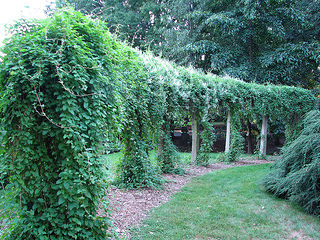Resource Library
Plant of the Week: Vines
Plant of the Week
Vines
 Vines, such as this fleece vine, are an important component of the garden flora, but
most plot revolution and overthrow while you tend the meek and mild plants in your
garden. (Image courtesy Gerald Klingaman)
Vines, such as this fleece vine, are an important component of the garden flora, but
most plot revolution and overthrow while you tend the meek and mild plants in your
garden. (Image courtesy Gerald Klingaman)
Download High Resolution
Plants represent the principal joy of gardening. The artistry of garden making is to combine all these plants in their astounding assortment of sizes, shapes and colors into a harmonious stew that looks good and works together as a unified whole. This is easy to say but harder to achieve in practice because plants – like people – have personalities. Some are spoiled and finicky while others are rotund bullies that want to take over.
Of the bullies – usually euphemistically referred to as “vigorous” or “robust” growers – vines head the list. Most vines, though with a few exceptions, don’t play well with others and must be carefully managed if they are to be used successfully in a garden planting.
Success with vines requires a good, well thought out plan and unrelenting, never-ending attention to maintenance. If you have a tendency to let things grow a bit wild before whipping them back into shape, don’t even consider adding vines to the garden.
Vines are happiest when they are growing in full sun, thus they have evolved a number of ways to climb on other plants to achieve this goal.
One of the most common climbing mechanisms is by twining stems around something for support. Wisteria, Japanese honeysuckle, bittersweet, akebia, Dutchman’s pipe and the notorious strangle fig of the tropics all have stems that systematically wrap themselves around support as they climb skyward. These are a good choice if you wish to cover a chain length fence or some other open framework but, should the vine ever need to be removed, this twining tendency makes removal from the trellis support almost hopeless.
Modified aerial roots are another common approach to climbing employed by poison ivy, trumpet vine, English ivy, wintercreeper euonymus and many others. These roots seek out crevices in tree bark or can adhere to flat surfaces such as vertical walls.
Modified leaves, called tendrils, are another approach used for climbing by many vines. At one time grapes had opposite leaf arrangement on the stem but through evolution one leaf was modified into a tendril that aids in climbing by twining around whatever is handy. In Boston ivy and Virginia creeper the tendrils have flat suction cups attached to their ends which cement them to walls. In climbers such as crossvine and sweet peas the terminal leaflet of each compound leaf is modified as a tendril. In clematis, a species just learning how to climb, the petiole of the leaf twines around whatever is handy.
Lastly there are the shrubs like climbing roses and bougainvilleas that don’t climb at all but instead sprawl over whatever is nearby, building up layer by layer until they own the space they occupy.
Even amongst the vines there are major differences in rambunctiousness. Wisteria heads the list of aggressive growers while clematis is a 90-pound weakling that just ekes out an existence in the border. Knowing in advance the nature of any vine you plant is critical because miscalculation on the front end will lead to disastrous results. The more vigorous the vine the larger the space that must be given it and the more carefully it must be isolated from its neighbors.
Wisteria, trumpet vine and their ilk should be planted around sturdy trellises that can be isolated from the rest of the landscape. An arbor covered with wisteria in the center of a sunny lawn can be an attractive landscape addition whereas the same feature in a mixed border surrounded by trees and shrubs will be a never-ending battle for dominance.
And then there is maintenance. Limits must be set for the spread of a vine and then ruthlessly adhered to. Fast growing vines in a small space should be treated as if they were a lawn with the vines cut back every couple weeks to maintain control. In addition to the top growth, vines must also be watched near their base because they can send out new plants either directly from the roots as seen in trumpet vine or by creeping surface stems as seen in akebia or wisteria. Vines can add a third dimension to the garden but they are not recommended for lazy gardeners. Don’t plant one unless you established the limits of its spread and worked out beforehand how it will be managed.
By: Gerald Klingaman, retired
Retired Extension Horticulturist - Ornamentals
Extension News - July 11, 2014
The University of Arkansas System Division of Agriculture does not maintain lists of retail outlets where these plants can be purchased. Please check your local nursery or other retail outlets to ask about the availability of these plants for your growing area.